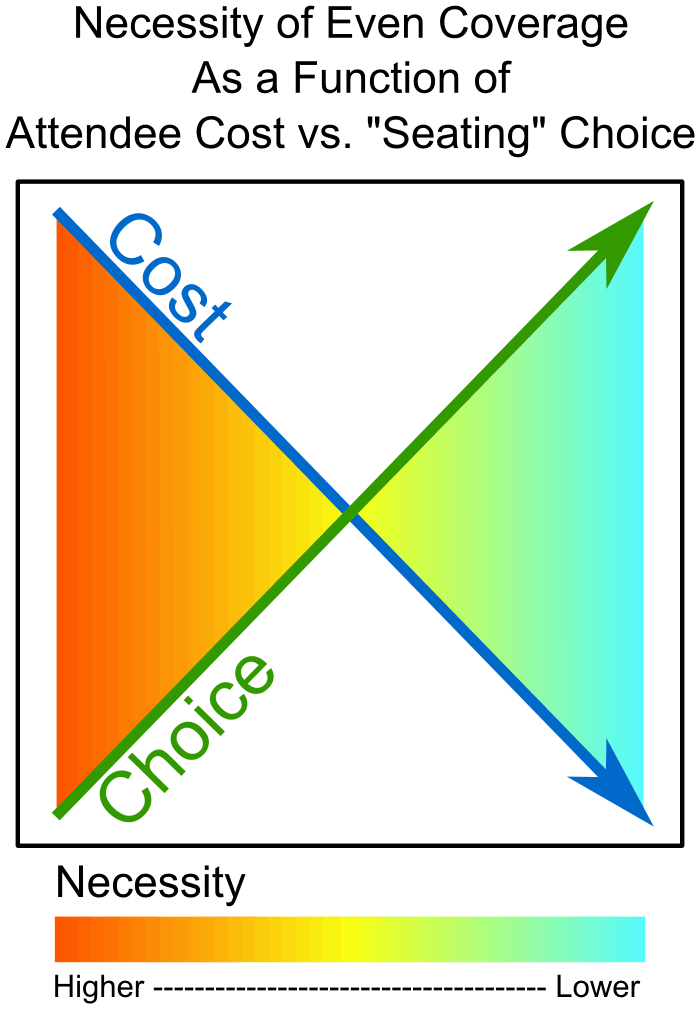Maximum coverage isn’t always appropriate for small venues.
Please Remember:
The opinions expressed are mine only. These opinions do not necessarily reflect anybody else’s opinions. I do not own, operate, manage, or represent any band, venue, or company that I talk about, unless explicitly noted.

 Want to use this image for something else? Great! Click it for the link to a high-res or resolution-independent version.
Want to use this image for something else? Great! Click it for the link to a high-res or resolution-independent version.I love the idea of a high-end, concert-centric install.
It excites me to think of a music venue where the coverage is so even that every patron is getting the same mix, +/- 3 dB. Creating audio rigs where “there isn’t a bad seat in the house” is a point of pride for concert-system installers, as well it should be.
Maximum coverage isn’t always appropriate, though. It can sometimes even be harmful. The good news is that an educated guess at the truly necessary coverage for live audio isn’t all that hard. It starts with audience behavior.
What Is The Audience Trying To Do?
Another way to put that question is, “What is the audience’s purpose?” At my regular gig, the answer is that they want to hang out, listen pretty informally, and socialize. This is an “averaged” assessment, by the way: Some folks want to focus entirely on the music. Some people barely want to focus on the tunes at all. Some folks would hate to be stuck in their seat. Some folks wouldn’t care.
The point is that there’s a mix of objectives in play.
This differs from going to show at, say, The State Room or, even more so, at Red Butte Garden. My perception of those events is that people go to them – paying a bit of a premium – with the intent to focus on the music.
At my regular gig, where there’s such a diversity of audience intent, perfectly even coverage of all areas in the room is counterproductive to that diversity. It forces a singular decision on everyone in the room. It essentially requires that everybody in attendance has the goal of being primarily focused on the music as a foreground element. This is a bad thing, because denying a large section of the audience their intended enjoyment is likely to encourage them to leave.
If they leave, that hurts us, and it hurts the band. As much as possible, we should avoid doing things that encourage folks to vamoose.
So, I’m perfectly happy to NOT cover everything. The FOH PA is slightly “toed in” to focus its output primarily on the area nearest the stage. The sound intensity is allowed to drop off naturally towards the back of the room, and there’s no attempt at all to fill the coverage gap off to the stage-left side. People often seem to congregate there, and my perception is that many of them do it to take a break from being in the direct fire of the PA. They can still hear the show, but the high-frequency content is significantly rolled off (at least for whatever is actually “in” the audio rig).
If I knew that almost everybody in the room was primarily focused on the music, I would take steps to cover the room more evenly. That’s not the case, though, so there are “hot” and “cool” coverage zones.
Cost/ Choice Parametrization
Another way to view the question of how much coverage is appropriate is to try to define the value that an attendee placed on being at a show, and how much choice they have in terms of their position at the show. This is another sort of thing that has to be averaged. Not all events (or people) in a certain venue are the same, so you have to look at what’s most likely to happen.
When you state the problem in terms of those parameters, you get something like this:
If the cost of being at the show is high (in terms of money, effort spent, overall commitment required, etc.) and the choice of precisely where to take in the show is low (say, assigned seating), then it’s very important to have consistent audio coverage for everyone. If people are paying hundreds of dollars and traveling long distances to see a huge band’s farewell or reunion, and they’re stuck in one seat at a theater, there had better be good sound at that seat!
On the other hand, it’s not necessary to cover every square inch of an inexpensive, “in town” show, where folks are free to move around. If the coverage isn’t what someone wants, they can move to where it is what they want – and, if they can’t get into the exact coverage area they desire, it’s not a huge loss. For a lot of small venues, this is probably what’s encountered most often.
Now, please don’t misconstrue what I’m saying. What I’m definitely NOT saying is that we should just “punt” on some gigs.
No.
As much as possible, we should assume that the most important show of our careers is the one we’re doing now.
What I’m saying is that we need to spend our effort on things that matter. We have to have a priorities list. If people want (and also have) options available for how they experience a show, then there’s no reason for us to agonize about perfect coverage. As I said above, academically perfect PA deployment might even be bad for us. They might not even want to be in the direct throw of our boxes, so why force them to be? In the world of audio, we have finite resources and rapidly diminishing returns. We have to focus on the primary issues, and if our primary issue is something OTHER than completely homogenous sound throughout the venue, then we need to direct our efforts appropriately.
